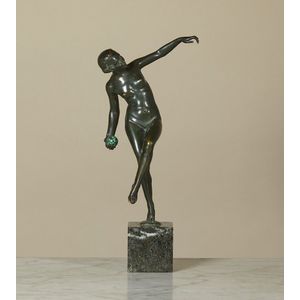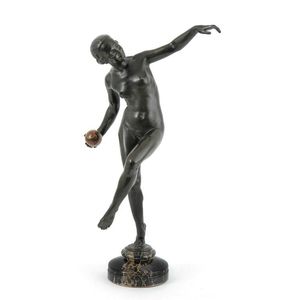
Bronze Nude on Marble Base by Lucien Alliot
Lucien Alliot (France, 1877-1967), cast bronze statue of a female nude on marble base, circa 1930, 45 cm high, 63 cm wide, 22 cm deep

Ball Dancer
Lucien (Charles Edouard) Alliot (French, 1877-1967), dancer with a ball c.1930, bronze, glass on marble base, signed in bronze base: L Alliot, height 30 cm (with base)

Bronze Sea Birds on Marble Base Sculpture
L Alliot bronze sea birds on marble base, approx 55 cm high, 76 cm long, 33 cm deep

"Old Friends" Bronze Figure Group by Lucien Alliot
A bronze figure group 'Old friends? by Lucien Alliot, French 1867-1967, 39 cm high.

Bronze Butterfly Lady Figure on Marble Base (9 words)
Alliot bronze butterfly lady figure on a marble base. Height 29 cm

French Art Deco Bronze Shot Putter on Marble Base
Lucien Alliot, French Art Deco bronze of female shot putter on marble base, height 32 cm. Provenance: Orlando Brown Collection, Mosman

Bronze Dancer with Marble Sphere, French 1925
An outstanding and extremely large bronze model of a naked dancer, signed, L. Alliot, French, circa 1925, holding a marble sphere in one hand, on marble base 88 cm high
 Loading more...
Loading more...